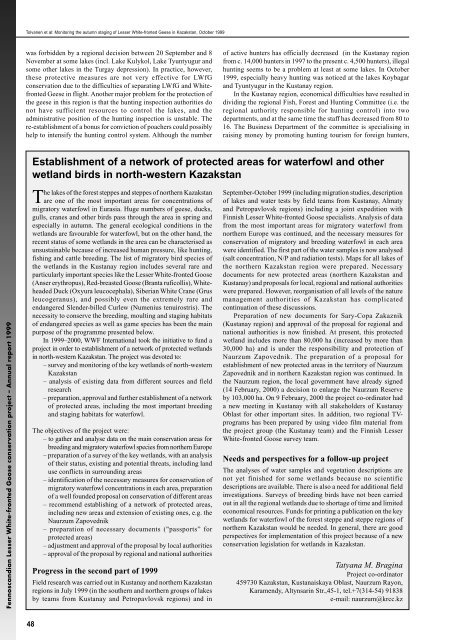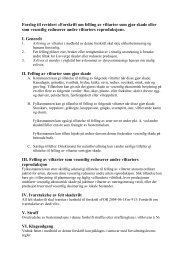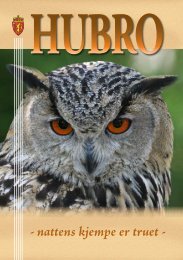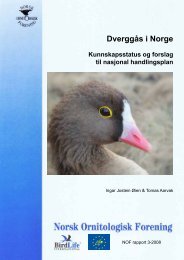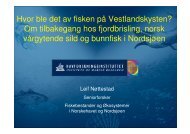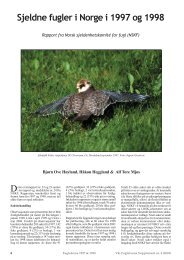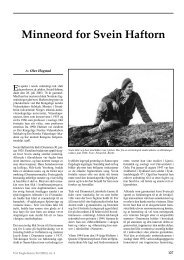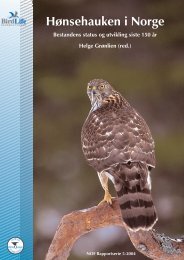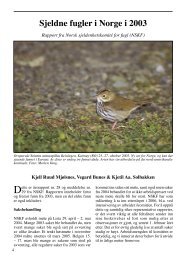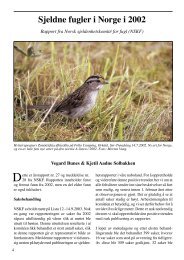Fennoscandian Lesser White-fronted Goose conservation project ...
Fennoscandian Lesser White-fronted Goose conservation project ...
Fennoscandian Lesser White-fronted Goose conservation project ...
You also want an ePaper? Increase the reach of your titles
YUMPU automatically turns print PDFs into web optimized ePapers that Google loves.
<strong>Fennoscandian</strong> <strong>Lesser</strong> <strong>White</strong>-<strong>fronted</strong> <strong>Goose</strong> <strong>conservation</strong> <strong>project</strong> – Annual report 1999<br />
Tolvanen et al: Monitoring the autumn staging of <strong>Lesser</strong> <strong>White</strong>-<strong>fronted</strong> Geese in Kazakstan, October 1999<br />
was forbidden by a regional decision between 20 September and 8<br />
November at some lakes (incl. Lake Kulykol, Lake Tyuntyugur and<br />
some other lakes in the Turgay depression). In practice, however,<br />
these protective measures are not very effective for LWfG<br />
<strong>conservation</strong> due to the difficulties of separating LWfG and <strong>White</strong><strong>fronted</strong><br />
Geese in flight. Another major problem for the protection of<br />
the geese in this region is that the hunting inspection authorities do<br />
not have sufficient resources to control the lakes, and the<br />
administrative position of the hunting inspection is unstable. The<br />
re-establishment of a bonus for conviction of poachers could possibly<br />
help to intensify the hunting control system. Although the number<br />
48<br />
Establishment of a network of protected areas for waterfowl and other<br />
wetland birds in north-western Kazakstan<br />
The lakes of the forest steppes and steppes of northern Kazakstan<br />
are one of the most important areas for concentrations of<br />
migratory waterfowl in Eurasia. Huge numbers of geese, ducks,<br />
gulls, cranes and other birds pass through the area in spring and<br />
especially in autumn. The general ecological conditions in the<br />
wetlands are favourable for waterfowl, but on the other hand, the<br />
recent status of some wetlands in the area can be characterised as<br />
unsustainable because of increased human pressure, like hunting,<br />
fishing and cattle breeding. The list of migratory bird species of<br />
the wetlands in the Kustanay region includes several rare and<br />
particularly important species like the <strong>Lesser</strong> <strong>White</strong>-<strong>fronted</strong> <strong>Goose</strong><br />
(Anser erythropus), Red-breasted <strong>Goose</strong> (Branta ruficollis), <strong>White</strong>headed<br />
Duck (Oxyura leucocephala), Siberian <strong>White</strong> Crane (Grus<br />
leucogeranus), and possibly even the extremely rare and<br />
endangered Slender-billed Curlew (Numenius tenuirostris). The<br />
necessity to conserve the breeding, moulting and staging habitats<br />
of endangered species as well as game species has been the main<br />
purpose of the programme presented below.<br />
In 1999–2000, WWF International took the initiative to fund a<br />
<strong>project</strong> in order to establishment of a network of protected wetlands<br />
in north-western Kazakstan. The <strong>project</strong> was devoted to:<br />
– survey and monitoring of the key wetlands of north-western<br />
Kazakstan<br />
– analysis of existing data from different sources and field<br />
research<br />
– preparation, approval and further establishment of a network<br />
of protected areas, including the most important breeding<br />
and staging habitats for waterfowl.<br />
The objectives of the <strong>project</strong> were:<br />
– to gather and analyse data on the main <strong>conservation</strong> areas for<br />
breeding and migratory waterfowl species from northern Europe<br />
– preparation of a survey of the key wetlands, with an analysis<br />
of their status, existing and potential threats, including land<br />
use conflicts in surrounding areas<br />
– identification of the necessary measures for <strong>conservation</strong> of<br />
migratory waterfowl concentrations in each area, preparation<br />
of a well founded proposal on <strong>conservation</strong> of different areas<br />
– recommend establishing of a network of protected areas,<br />
including new areas and extension of existing ones, e.g. the<br />
Naurzum Zapovednik<br />
– preparation of necessary documents ("passports” for<br />
protected areas)<br />
– adjustment and approval of the proposal by local authorities<br />
– approval of the proposal by regional and national authorities<br />
Progress in the second part of 1999<br />
Field research was carried out in Kustanay and northern Kazakstan<br />
regions in July 1999 (in the southern and northern groups of lakes<br />
by teams from Kustanay and Petropavlovsk regions) and in<br />
of active hunters has officially decreased (in the Kustanay region<br />
from c. 14,000 hunters in 1997 to the present c. 4,500 hunters), illegal<br />
hunting seems to be a problem at least at some lakes. In October<br />
1999, especially heavy hunting was noticed at the lakes Koybagar<br />
and Tyuntyugur in the Kustanay region.<br />
In the Kustanay region, economical difficulties have resulted in<br />
dividing the regional Fish, Forest and Hunting Committee (i.e. the<br />
regional authority responsible for hunting control) into two<br />
departments, and at the same time the staff has decreased from 80 to<br />
16. The Business Department of the committee is specialising in<br />
raising money by promoting hunting tourism for foreign hunters,<br />
September-October 1999 (including migration studies, description<br />
of lakes and water tests by field teams from Kustanay, Almaty<br />
and Petropavlovsk regions) including a joint expedition with<br />
Finnish <strong>Lesser</strong> <strong>White</strong>-<strong>fronted</strong> <strong>Goose</strong> specialists. Analysis of data<br />
from the most important areas for migratory waterfowl from<br />
northern Europe was continued, and the necessary measures for<br />
<strong>conservation</strong> of migratory and breeding waterfowl in each area<br />
were identified. The first part of the water samples is now analysed<br />
(salt concentration, N/P and radiation tests). Maps for all lakes of<br />
the northern Kazakstan region were prepared. Necessary<br />
documents for new protected areas (northern Kazakstan and<br />
Kustanay) and proposals for local, regional and national authorities<br />
were prepared. However, reorganisation of all levels of the nature<br />
management authorities of Kazakstan has complicated<br />
continuation of these discussions.<br />
Preparation of new documents for Sary-Copa Zakaznik<br />
(Kustanay region) and approval of the proposal for regional and<br />
national authorities is now finished. At present, this protected<br />
wetland includes more than 80,000 ha (increased by more than<br />
30,000 ha) and is under the responsibility and protection of<br />
Naurzum Zapovednik. The preparation of a proposal for<br />
establishment of new protected areas in the territory of Naurzum<br />
Zapovednik and in northern Kazakstan region was continued. In<br />
the Naurzum region, the local government have already signed<br />
(14 February, 2000) a decision to enlarge the Naurzum Reserve<br />
by 103,000 ha. On 9 February, 2000 the <strong>project</strong> co-ordinator had<br />
a new meeting in Kustanay with all stakeholders of Kustanay<br />
Oblast for other important sites. In addition, two regional TVprograms<br />
has been prepared by using video film material from<br />
the <strong>project</strong> group (the Kustanay team) and the Finnish <strong>Lesser</strong><br />
<strong>White</strong>-<strong>fronted</strong> <strong>Goose</strong> survey team.<br />
Needs and perspectives for a follow-up <strong>project</strong><br />
The analyses of water samples and vegetation descriptions are<br />
not yet finished for some wetlands because no scientific<br />
descriptions are available. There is also a need for additional field<br />
investigations. Surveys of breeding birds have not been carried<br />
out in all the regional wetlands due to shortage of time and limited<br />
economical resources. Funds for printing a publication on the key<br />
wetlands for waterfowl of the forest steppe and steppe regions of<br />
northern Kazakstan would be needed. In general, there are good<br />
perspectives for implementation of this <strong>project</strong> because of a new<br />
<strong>conservation</strong> legislation for wetlands in Kazakstan.<br />
Tatyana M. Bragina<br />
Project co-ordinator<br />
459730 Kazakstan, Kustanaiskaya Oblast, Naurzum Rayon,<br />
Karamendy, Altynsarin Str.,45-1, tel.+7(314-54) 91838<br />
e-mail: naurzum@krcc.kz


